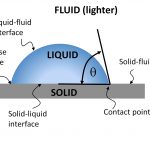A new review on contact angles from SURFI team has been published in the Advances in Colloid and Interface Science journal, entitled Contact Angles: From Past Mistakes to New Developments through Liquid-Solid Adhesion Measurements.
A contact angle observed for a liquid-solid system is not necessarily a unique value and a few different contact angles need to be carefully considered in relation to liquid spreading, adhesion and phase separation. Despite the conceptual simplicity of the contact angle and over 200 years of investigation, interpretations of experimental contact angles remain controversial, and mistakes are quite common. Here, the physics behind equilibrium contact angles are restated and their misuse in modern literature is briefly discussed. Selected advances made in the 20th century that shaped current interpretations of experimental contact angles are also critically reviewed and evaluated. Understanding of contact angles for liquids on solids has improved in the last two decades and this progress is driven by advanced imaging techniques and improved methodologies in contact angle measurements, often in tandem with direct force measurements for liquid droplets in contact with solids. In our laboratory, a microelectronic balance system is employed to measure the force of liquid droplet spontaneous spreading and the water-solid adhesion forces at different stages of droplet retraction and separation. A microbalance equipped with a camera and data acquisition software measures these forces directly, monitors droplet-surface separation including distances over which the droplet stretches, and collects optical images simultaneously. The images are used to analyze capillary and surface tension forces based on measured droplet dimensions, shapes of surfaces and values of contact angles. These force measurements have significantly furthered our fundamental understanding of advancing, receding and most stable contact angles, and their correlations with adhesion, and are summarized in this review.
Correcting Contact Angles
This entry was posted in Publications. Bookmark the permalink.

